New perk: Easily find new routes and hidden gems, upcoming running events, and more near you. Your weekly Local Running Newsletter has everything you need to lace up! Subscribe today.
I ran 12 marathons before the Tokyo Marathon, 10 of which were World Marathon Majors, but I’d never felt so nervous leaving my hotel room before a race as I did on the first Sunday in March last year. Before leaving for Japan, I had to record my health stats in an app for two straight weeks and then pass a temperature check in the airport; at the race expo, I was given two COVID-19 tests to take and upload before race day. After all that, I had to show all that documentation just to enter the corrals. Forget race nerves; I was terrified something would prevent me from even crossing the start line.
I was registered for the Tokyo Marathon in 2020, when the race was canceled for non-elite runners because of the Covid-19 pandemic; and after it was also canceled again in 2021 and 2022, I didn’t get to run it until 2023. By that point, it was the only star remaining on my six-star journey, and the anticipation of fulfilling that goal had built up the Tokyo Marathon into this almost mythical event for me. And I wasn’t the only one; as the crowds huddled together to block the wind whipping around the Tokyo Metropolitan Government Building at the start, the eager excitement was palpable. Once the start gun went off—along with a shower of confetti—that energy propelled me across the start line into a race I really didn’t know much about.
Of all the World Marathon Majors, the Tokyo Marathon remains the most elusive and mysterious to most runners. Even without taking into account the difficulty of getting into the race—of the approximately 38,000 runners in 2023, only about 12,000 of those were from overseas—the financial investment and logistics of traveling halfway across the world make this race a reach goal for many people. And with so few runners from the U.S. going each year and online advice that tends to get lost in translation, it can be hard to know what you’re getting yourself into on race day.
RELATED: 9 Things to Know About Eliud Kipchoge and the Tokyo Marathon
The Jet Lag Factor
I’ve traveled to Berlin and London for those marathons, but the jet lag of traveling from the U.S. to Europe is nothing compared to traveling to Asia. Tokyo is a 14- to 17-hour time difference from most of the United States; I left from the West Coast on Tuesday morning and landed in Japan on the Wednesday afternoon before the race. (In retrospect, this would have been the flight to splurge for an upgrade; I didn’t sleep at all during the 12-hour journey).
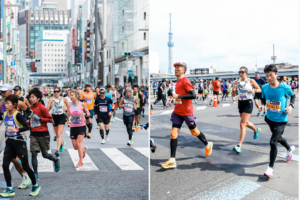
Generally, you should plan to arrive at least three to four days before race day to give yourself time to adjust—your body needs about one full day per time zone crossed in order to reorient its circadian rhythm, according to the American Sleep Association. I’d recommend going even earlier, if you have that flexibility, but no matter when your flight is, slowly shifting your bedtime earlier (if you’re flying east) or later (if you’re flying west) to be closer to Tokyo time at least a week before the race can help the adjustment.
This kind of prolonged travel can have a physical and cognitive toll on athletes that may adversely affect performance in competition, older research published in the journal Sports Health determined; even with 10-plus hours of sleep every night the week of the race, it still took until race day to get my sleep (mostly) back on track, and I definitely felt the effects of jet lag in the final 10K of the race.
RELATED: Data Shows There’s No One Way to Train for a Marathon
How to Prepare for the Tokyo Marathon
Whatever you do before this particular race, don’t get sucked into the rabbit hole of marathon message boards. So far this year, people have asked me if it’s true that you can’t wear crop tops on the Tokyo Marathon course, whether it’s true that you can’t throw away extra layers in the corrals, if you really have to take fluids/snacks from the aid station corresponding to your bib number, if you’ll get in trouble for dropping gels on the ground. and what’s actually allowed through the security at the corrals. The simple answer: The rules are pretty much the same as every other big city marathon, including New York, Boston, London, Chicago, and Berlin.

When I ran Tokyo in 2023, the country was still under a mask mandate and there were all kinds of regulations in place related to the COVID-19 pandemic. That’s changed this year, and while the Runner’s Handbook is very thorough, there are some things that might seem confusing and some things in it that will seem different from other marathons. The best thing you can do is bring all your questions to the marathon expo, which is impeccably organized and efficient. (Last year, I even had to ask a volunteer where to download the race tracking app—no matter what I read online, I couldn’t figure out what it was called in Japanese).
RELATED: Your 2024 Boston Marathon Medal Will Be Made of Recycled Materials
What to Expect from the Tokyo Marathon Course
While the rest of the World Marathon Majors are essentially large loops or point-to-point courses, the Tokyo Marathon course is unique in that it has at least five large out-and-backs, which means you cover a lot of the same ground twice. Some runners may find that mentally challenging, but I actually enjoyed passing other runners—at one point, I even saw the elite runners blowing by us on the other side of the road, and I made a game of trying to spot my friends running faster than me on the other side of the median.
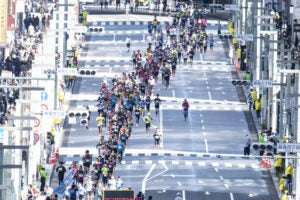
Overall, the course is flat and fast: Kenya’s Eliud Kipchoge and Brigid Kosgei both set course records here in 2022, clocking 2:02:40 and 2:16:02, respectively. Runners start on a cruise-y downhill for four miles (my Strava recorded an elevation loss of 115 feet), and then the course levels out; at no point do runners gain more than 10 feet in a mile. It winds through several districts of the city, including Shinjuku, Suidobashi, Sudacho, Kanda, Nihombashi, Asakusa, Ryogoku, Ginza, and Hibiya. While those areas are full of shrines, temples, parks, luxury stores, and museums, I saw none of it (except the Tokyo Tower near the end); I mostly just remember gargantuan commercial buildings, like running through a city’s financial district.
Something to keep in mind: There are no on-course bathrooms. Instead, you’ll see signs directing you to toilets 200 or even 400 meters off the course. Make sure you use the bathroom plenty of times before entering the corrals (there are no bathrooms there, either) so you don’t end up adding a quarter-mile or more to your race distance.
RELATED: Will Sydney Become the Next World Marathon Major?
What to Expect from the Crowds
Another big difference between the American and European Majors and the Tokyo Marathon is the spectator vibes. While Americans and Europeans yell and shout their encouragement, the Japanese are much quieter—there’s lots of waving, jumping, and golf-clapping. I live for the energy of the New York City Marathon (that’s why I’ve run that race six times), so I was nervous after hearing people talk about how quiet Tokyo was in comparison. But I ran the first 18 miles with headphones, and the excitement of the crowd was still obvious. The only tough part was the final out-and-back; the transit options make it difficult for spectators to get to this area, so it was noticeably quieter and my headphones had died, which made digging deep in those final miles a little tougher.
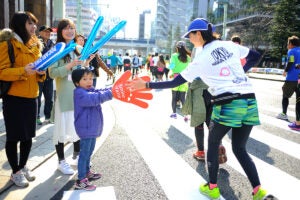
The course itself is also crowded with runners—in 2023, there were 38,423 total participants, and 36,571 finishers. Despite all the times I’ve run NYC, I’ve never experienced such a packed mass start as we all spilled out of the Tokyo Marathon corral (Tokyo’s general sense of order and rule-following did not apply here). There’s a lot of weaving in the first few miles and it eventually spreads out a bit (it doesn’t stay as crowded as London and Berlin), but it was still incredibly packed at the finish. The plus side of that: seeing other runners on the out-and-backs provides welcome support even on quieter parts of the course.
Watch: This Six-Star Marathon Finisher Runs for Representation
Other Things to Keep In Mind
Tokyo is a massive city—like 10 (or more) Manhattans all stacked in a row. You do not want to explore it by foot in the days leading up to the race. You can actually buy a Suica transit card ahead of time and keep it in your Apple Wallet; Tokyo’s transit system can seem a little overwhelming, but it’s surprisingly easy to navigate and most people speak enough English to help you get where you need to go. I also took plenty of Ubers, which were mostly cheaper than what you’d find in other major marathon cities.
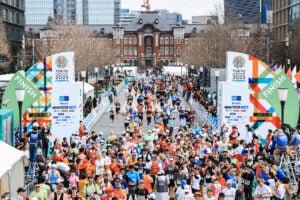
Japan is known for its gourmet-esque 7-Elevens, but if you’re carb-loading for a race and relying on specific foods like protein bars or crackers, bring them with you. It’s very difficult to find familiar items (I ate a lot of Kit Kat bars for extra calories), and the days before the race aren’t the best time to experiment with unknown snacks. Most hotel breakfasts will include continental breakfast items, but if there’s anything you know you want on race day—for example, bagels and peanut butter—pack them in your checked bag.
Pro tip: make a dinner reservation for the night before the race. Restaurants in Tokyo tend to be small, and the westernized ones will be packed with runners. I had pizza and pasta at Seirinkan, a Neopolitan pizza place that’s been featured in David Chang’s “Ugly Delicious” and is full of Japan-related Beatles memorabilia; no one else there looked like they were running the marathon, which was a welcome break after the all the craziness of the expo and other race-related events.
RELATED: Pack Your Bags and Running Shoes for These Destination Races
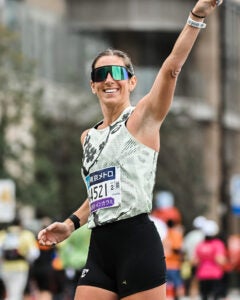
Ashley Mateo is a writer and UESCA- and RRCA-certified running coach. She has completed 15 marathons, and finished her six-star journey in Tokyo in 2023.
